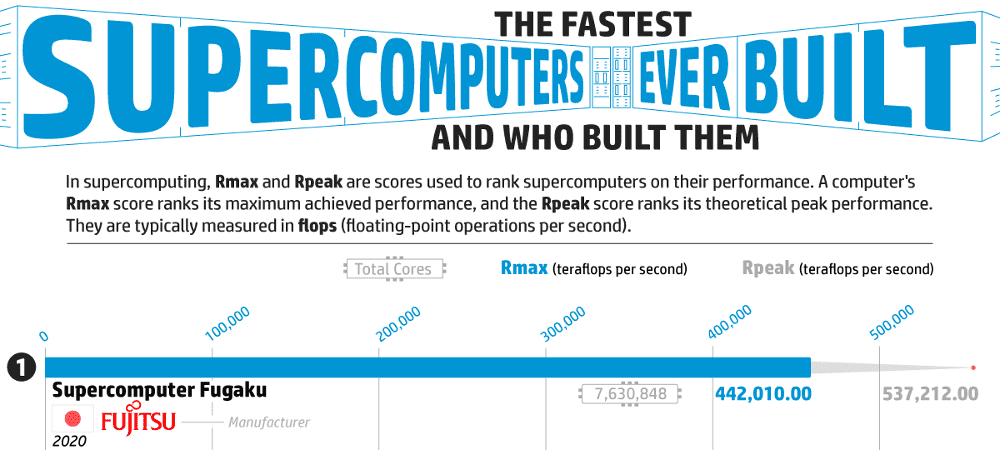We use cookies to offer you a better experience. For more information on how we use cookies you can read our Cookie and Privacy Policy.
The Fastest Supercomputers Ever Built and Who Built Them
May 31, 2021

What is a supercomputer? A supercomputer is generally described as a computer with an incredibly high level of performance. Supercomputers are an important part of computational science, including weather forecasting, climate research, quantum mechanics, molecular modeling, and cryptanalysis, as they are able to process information more quickly than a traditional computer. The United States has historically been a leader in supercomputer development, but other countries’ technology and research have been catching up.
The HP research team consulted data from supercomputer ranking project TOP500 to visualize the most powerful supercomputers in the world as well as their country and company of development.
Click to view the full-size infographic

The Fastest Supercomputers in the World
Supercomputers are typically ranked by Rmax, which is the score that measures their maximum achieved performance measured in teraflops, or a processor's ability to calculate one trillion floating-point operations per second. They can also be ranked by their Rpeak score, which is the supercomputer’s theoretical peak performance. These are the top 10 fastest supercomputers in the world ranked by their Rmax score:
- Supercomputer Fugaku: 442,010.00 teraflops per second
- Summit: 148,600.00 teraflops per second
- Sierra: 94,640.00 teraflops per second
- Sunway TaihuLight: 93,014.59 teraflops per second
- Selene: 63,460.00 teraflops per second
- Tianhe-2A: 61,444.50 teraflops per second
- JUWELS Booster Module: 44,120.00 teraflops per second
- HPC5: 35,450.00 teraflops per second
- Frontera: 23,516.40 teraflops per second
- Dammam-7: 22,400.00 teraflops per second
The most powerful computer in the world is the Fugaku supercomputer. This Japanese supercomputer, which resides at the RIKEN Center for Computational Science and was completed in 2020, has an Rmax score of an astounding 442,010.00 teraflops per second and an Rpeak score of 537,212.00 teraflops per second. That’s nearly three times the processing power of the supercomputer in second place! It contains a Fujitsu A64FX microprocessor, uses a Linux operating system, and has more than 7.6 million cores, making it the fastest computer in the world and exponentially faster than a typical consumer desktop computer.
Which Companies and Countries Have Produced the Most Supercomputers?
Among the top 50 fastest supercomputers currently in existence, these are the countries that have created the most:
- United States: 16
- Japan: 10
- France: 5
- Germany: 5
- Italy: 3
- China: 2
- Australia: 1
- Russia: 1
- Saudi Arabia: 1
- South Korea: 1
- Spain: 1
- Switzerland: 1
- Taiwan: 1
- United Arab Emirates: 1
- United Kingdom: 1
These are the technology companies that have had a hand in developing the top 50 fastest supercomputers. Because some supercomputers on the list were worked on by more than one company, these numbers add up to more than 50:
- Hewlett Packard Enterprise: 16
- Cray Inc.: 9
- Atos: 7
- Fujitsu: 6
- IBM: 6
- NVIDIA: 6
- Dell EMC: 3
- Lenovo: 3
- Hitachi: 2
- Mellanox: 2
- ASUS Cloud: 1
- National Research Center of Parallel Computer Engineering & Technology: 1
- NEC: 1
- Quanta Computer: 1
- Taiwan Fixed Network: 1
- The National University of Defense Technology: 1
Hewlett Packard Enterprise has been involved in the development of 32% of the supercomputers on this list, including Damman-7, Piz Daint, Trinity, and Hawk.
Article reposted with permission from HP Tech Takes






